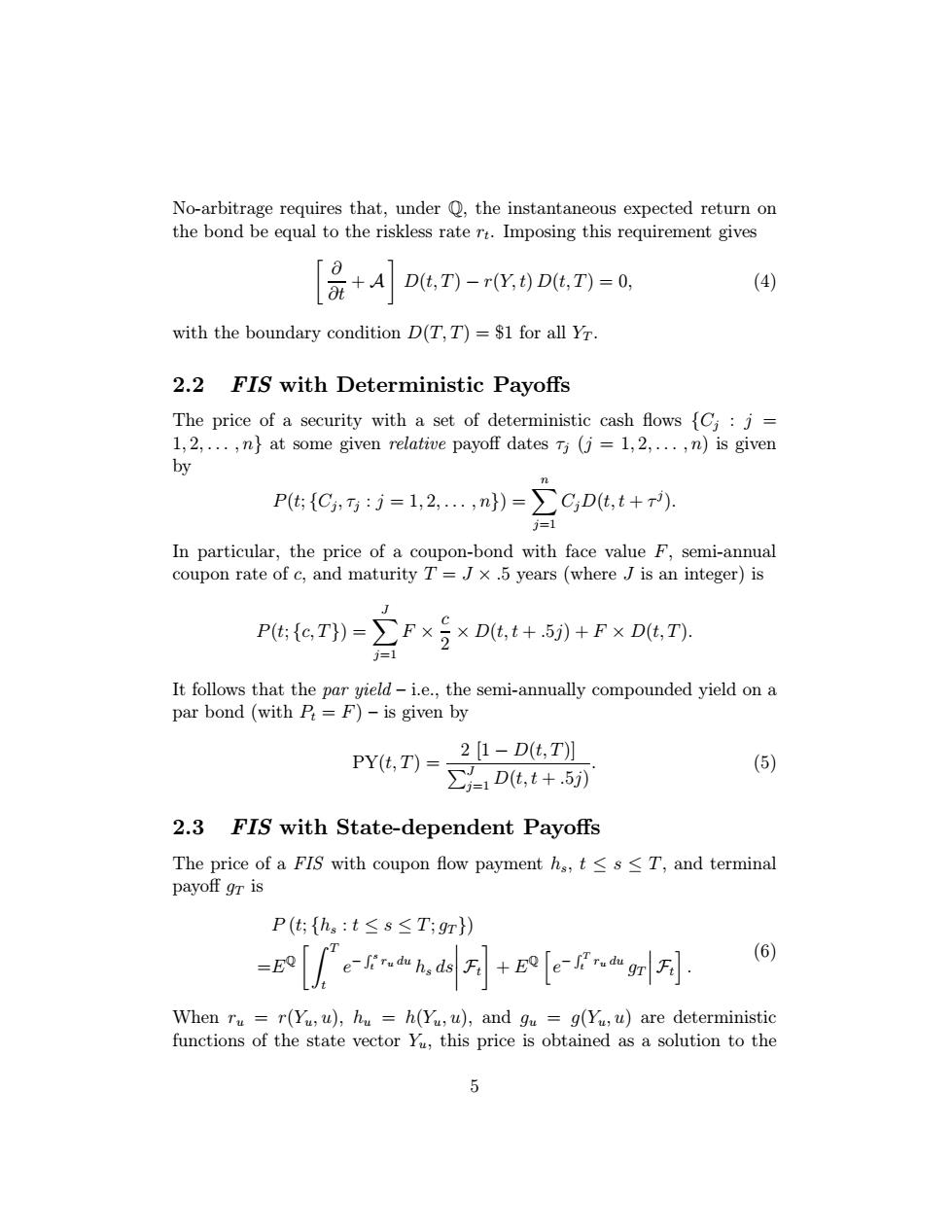正在加载图片...

No-arbitrage requires that,under Q,the instantaneous expected return on the bond be equal to the riskless rate rt.Imposing this requirement gives [品+ D(t,T)-r(Y,t)D(t,T)=0, (4) with the boundary condition D(T,T)=$1 for all Yr. 2.2 FIS with Deterministic Payoffs The price of a security with a set of deterministic cash fows [Ci:j= 1,2,...,n}at some given relative payoff dates Ti(j=1,2,...,n)is given by Pe{C,:j=1,2,,m)=∑C,D,t+r) 1 In particular,the price of a coupon-bond with face value F,semi-annual coupon rate of c,and maturity T=Jx.5 years (where J is an integer)is J Pt{c,T)=∑F×5xDt,t+5)+FxD6,T. 1=1 It follows that the par yield-i.e.,the semi-annually compounded yield on a par bond (with P=F)-is given by PY(t,T)= [1-D(t,T)] ∑1Dt,t+.5列 (5) 2.3 FIS with State-dependent Payoffs The price of a FIS with coupon flow payment hs,t<s <T,and terminal payoff gr is P(t;{hs:t≤s≤T;gr}) -B[eia%叫+[eRg如小 (6) When ru=r(Yu,u),hu h(Yu,u),and gu=g(Yu,u)are deterministic functions of the state vector Yu,this price is obtained as a solution to the 5No-arbitrage requires that, under Q, the instantaneous expected return on the bond be equal to the riskless rate rt. Imposing this requirement gives ∂ ∂t + A D(t, T) − r(Y, t) D(t, T)=0, (4) with the boundary condition D(T,T) = $1 for all YT . 2.2 FIS with Deterministic Payoffs The price of a security with a set of deterministic cash flows {Cj : j = 1, 2,... ,n} at some given relative payoff dates τj (j = 1, 2,... ,n) is given by P(t; {Cj , τj : j = 1, 2,... ,n}) = Xn j=1 CjD(t, t + τ j ). In particular, the price of a coupon-bond with face value F, semi-annual coupon rate of c, and maturity T = J × .5 years (where J is an integer) is P(t; {c, T}) = X J j=1 F × c 2 × D(t, t + .5j) + F × D(t, T). It follows that the par yield – i.e., the semi-annually compounded yield on a par bond (with Pt = F) – is given by PY(t, T) = 2 [1 − D(t, T)] PJ j=1 D(t, t + .5j) . (5) 2.3 FIS with State-dependent Payoffs The price of a FIS with coupon flow payment hs, t ≤ s ≤ T, and terminal payoff gT is P (t; {hs : t ≤ s ≤ T; gT }) =EQ Z T t e− R s t ru du hs ds
Ft + EQ h e− R T t ru du gT
Ft i . (6) When ru = r(Yu, u), hu = h(Yu, u), and gu = g(Yu, u) are deterministic functions of the state vector Yu, this price is obtained as a solution to the 5